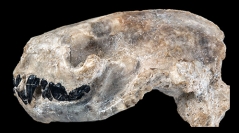

 Geodiversitas
38 (4) - Pages 543-558
Geodiversitas
38 (4) - Pages 543-558The upper Miocene sites of Hadjidimovo and Kalimantsi in southwestern Bulgaria have yielded fossils of three musteloids: the ailurid Simocyon Wagner, 1858, the mustelid Promeles Zittel, 1890, and several skulls of Promephitis Gaudry, 1861, an Eurasian member of the Mephitidae. Extant mephitids are represented by three New World and one South-Asian genera. Palaeomephitis Jäger, 1839, Miomephitis Dehm, 1950, and Proputorius Filhol, 1890, from the Middle Miocene of Europe, as well as several American Clarendonian to Hemphillian (late middle to late Miocene) genera have also been ascribed to the Mephitidae. We show that the mephitid status of Palaeomephitis, Miomephitis, and Proputorius is doubtful, and that the late Miocene Promephitis is at a lower grade of encephalization than modern Mephitidae and could be the sister taxon of Pleistocene and modern forms, which can be called Mephitinae. Within this subfamily, the American Pleistocene and modern taxa form the sister group of the Asian Mydaus Cuvier, 1821, which displays numerous autapomorphies. A major, previously unnoticed characteristic of the Mephitinae and Promephitis is that their P4 lingual cusp is an hypocone, unlike that of the Clarendonian American forms, in which it is a protocone. The latter taxa should therefore be excluded from the Mephitidae, although they are probably closely related.
Mammalia, Carnivora, Mephitidae, upper Miocene, Bulgaria.